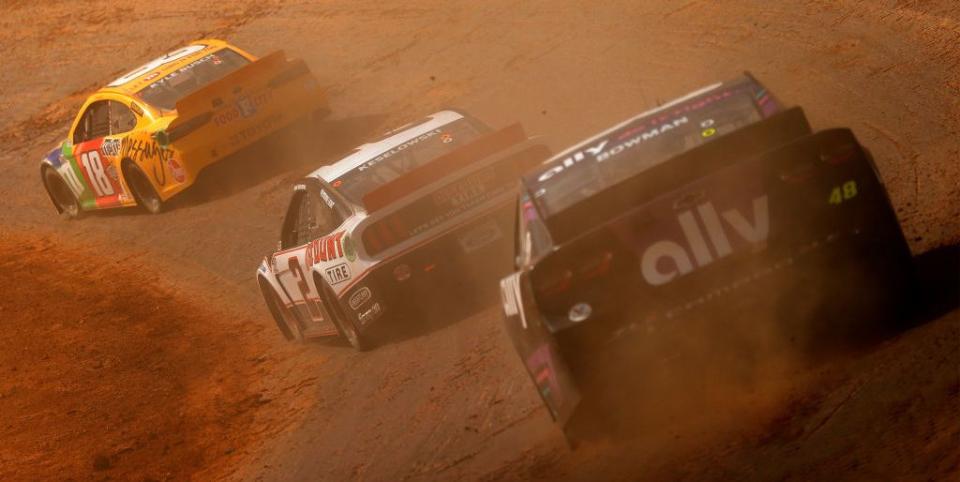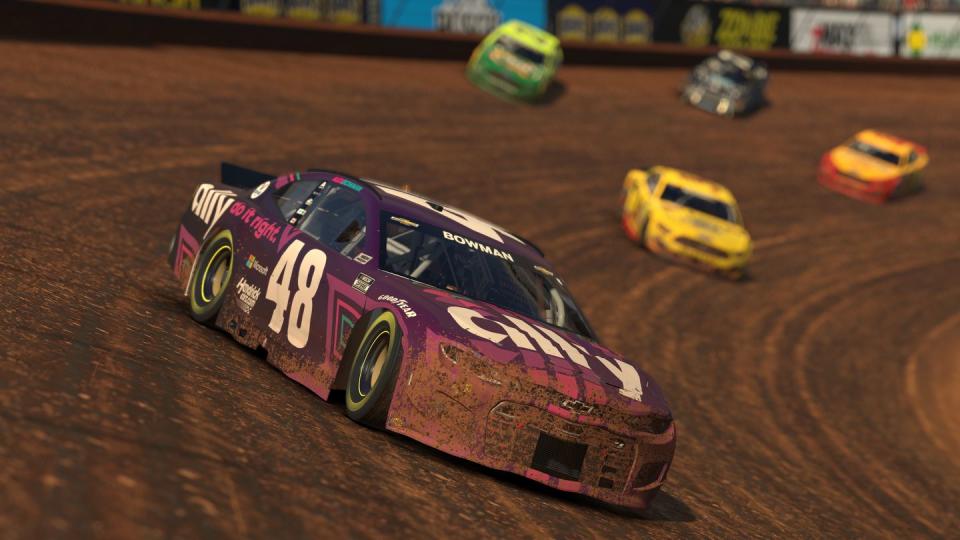Everything You Need to Know about NASCAR’s Bristol Dirt Race

The NASCAR Cup Series will contest its first race on dirt since 1971 on March 28 at Bristol Motor Speedway.
The track’s traditional concrete surface has been covered with multiple layers of clay to create a temporary 18-degree banked dirt track.
Inclement weather canceled the heat races that were originally crafted to set the starting lineup for both the Cup Series and Truck Series events.
For the first time since 1970, the NASCAR Cup Series will race on dirt this weekend, but it’s not going to take place on a traditional dirt track.
Instead, Speedway Motorsports Inc. has temporarily converted Bristol Motor Speedway into a half-mile dirt track, covering its concrete surface with nearby ‘Bluff City Clay’ for a Cup Series/Truck Series doubleheader replete with heat races to set the starting lineups.
The inclusion of a dirt race is just one of many changes to the Cup Series schedule this season, in addition to seven races on road courses, and with a downtown city street course event also under consideration for future seasons alongside the debut of the next-generation race car.
It’s been 51 years since the highest level of NASCAR raced on clay, dating back to the 1970 Home State 200 at the North Carolina State Fairgrounds in Raleigh, when Richard Petty defeated Neil Castles by two laps.

“That was a different time, and I think we all knew that after Raleigh that night there weren’t going to be any more dirt-track races,” the seven-time champion told Autoweek. “We knew it was last one that (48-race) season and we sort of already knew there wouldn’t be any more the next season. (Petty Enterprises) didn’t even have a dirt-track car at that time; all of ours were set up for asphalt. We used a Plymouth we’d sold to Jabe Thomas earlier in the year. His owner (Don Robertson) let us use of one his cars that night. Really, I don’t remember much about the race itself.”
Petty, by the way, wasn’t a fan of this idea when it first came out.
That race was seen as the end of an era, with NASCAR abandoning its dirt roots for state-of-the-art pavement facilities like Daytona Superspeedway, Talladega Superspeedway, Darlington Raceway, and Rockingham Speedway.
Another quarter century would pass and paved short tracks like North Wilkesboro Speedway and Fairgrounds Speedway Nashville would also be removed from the schedule in favor of similarly constructed intermediate tracks like Chicagoland Speedway and Kentucky Speedway.
It didn’t take long for aerodynamics and engineering to suppress the entertainment value at these 1.5-mile tracks and fans pushed for a return to short tracks while also introducing more road courses in addition to Watkins Glen and Sonoma.
First came the Charlotte Motor Speedway Roval, which came at the expense of the fall race on the original intermediate length D-shaped oval, with Chicagoland and Kentucky falling off the schedule in 2021 to make room for traditional road courses like Circuit of the Americas and Road America.
NASCAR will soon begin a reconfiguration of two-mile Auto Club Speedway in Southern California into a half-mile short track. Fairgrounds Speedway Nashville, which last hosted the Cup Series in 1984, is nearing closer to a revival that could see it return to the highest levels of the sport.
The Truck Series was the first to return to NASCAR’s dirt track roots, contesting a successful seven-year stint at Eldora Speedway in Rossburg, Ohio.
It was inevitable that the Cup Series would follow suit, and with attendance beginning to dwindle at Bristol, the decision was made to convert that event to a dirt race—20 years after the track last covered its surface in clay for the World of Outlaws.
The Food City Dirt Race is one of the most anticipated and unpredictable NASCAR races in decades, so here is a primer for what to expect as Thunder Valley and Cup Series gets dirty.
How did NASCAR set the starting lineups?
Unfortunately, a torrential downpour canceled the heat races that were intended to set the starting lineups for both races and postponed the Truck Series race to Sunday night at 9 p.m.
As a result, Trevor Collins, Jessica Friesen, and Ryan Newman failed to make the race. JR Heffner withdrew earlier in the afternoon.
The starting order was determined by the formula has been used since last season with the absence of qualifying. The formula combines owner points, previous week’s finish, and fastest lap of the previous week's race.
It’s worth noting that Kyle Larson will start at the rear of the Cup Series race due to an engine change.
NASCAR Cup Series and Truck Series Bristol Dirt starting lineups pic.twitter.com/UENhLzU1Lf
— Matt Weaver (@MattWeaverAW) March 27, 2021
What’s the format for the features?
First, the feature is what dirt fans call ‘the main event.’ It’s also called an A-Main or A-Feature. Similar to an ordinary NASCAR event, both the Cup Series and Truck Series races will be divided into three stages, but changes to the format were implemented after Friday practice produced a tremendous amount of tire wear.
Here’s the updated format:
Competition caution on Lap 50
Stage 1 ends at Lap 100 instead of Lap 75
Competition caution on Lap 150
Stage 2 ends at Lap 200 instead of Lap 150
Laps will not count once NASCAR sends the free pass car around during the competition cautions on Lap 50 and 150
An additional set of tires has been provided to teams—a total of six overall
What rules package is the Cup Series using?
This is a modified version of the higher horsepower, low downforce rules formula used on short tracks and road courses.
However, there will be no splitter overhang and a debris deflector will be permitted at a maximum of 18 inches by 6 inches. Unlike dirt Late Models, Cup cars will utilize windshields. The rear spoiler will be 6 inches by 51 inches, which is different from that used on superspeedway (9 x 61) and short tracks and road courses (2.75 x 61). Screens will be placed over various ducts to keep dirt and mud out. The right sides of the cars, which are expected to be tested by the outside retaining wall, will be given body stiffeners. Deck-lid hinges will be used, and spindle and steering arm assembly can be reinforced.
There will not be pit stops this weekend
Over-the-wall crew members won’t even be at the track this weekend as this race will not feature traditional pit stops.
Once a stage ends, the running order will be frozen, and the field will be allowed to come down pit road for any refueling, set-up adjustments, or repairs. The order on pit road will be the order off pit road unless a penalty is called. Those who choose not to pit will start ahead of those who came down pit road.
NASCAR did consider implementing pit stops but NASCAR senior vice president of competition Scott Miller explained his team couldn’t land on the right format.
“We kind of toyed around with the idea of could we or couldn’t we have pit stops like we normally see every week,” Miller said. “Honestly, with dirt cars on a dirty concrete pit road, having pit crews trying to run out there and do all of that, I just don’t think that would have been in our best interest, especially the first time around.”
Is this a one and done?
There has been some speculation that this was intended to be a one-off event since there will be no need for the current generation cars after this season. Further, there may be reluctance to put the Next-Gen cars on dirt, given that there could be a considerable amount of carnage this weekend.
Miller says such a determination hasn’t been made.
“If we have an event that is as fantastic as we all are hoping that it will be, which we all believe that it will be, then we will figure out a way to make it continue on,” Miller said.
“If we have problems, we’d have to look at it for what the future is. I think it’s safe to say if we have an overwhelming successful event, we’ll figure out a way to carry on with it.”
And what constitutes a success?
“I mean, it has to come off good from a TV perspective and attendance perspective, fan feedback perspective, a ratings perspective,” Miller said. “It’s just all of those things.”
OK, so how can we watch?
The NASCAR Food City Dirt Race will take place at 3:30 p.m. ET on Sunday. It will air on FOX. The rain delayed Truck Series race is scheduled to take place at 9:00 p.m. ET on FS2.
Will you be watching this week? How do you feel about the NASCAR Cup Series on dirt? Tell us in the comments section below.

